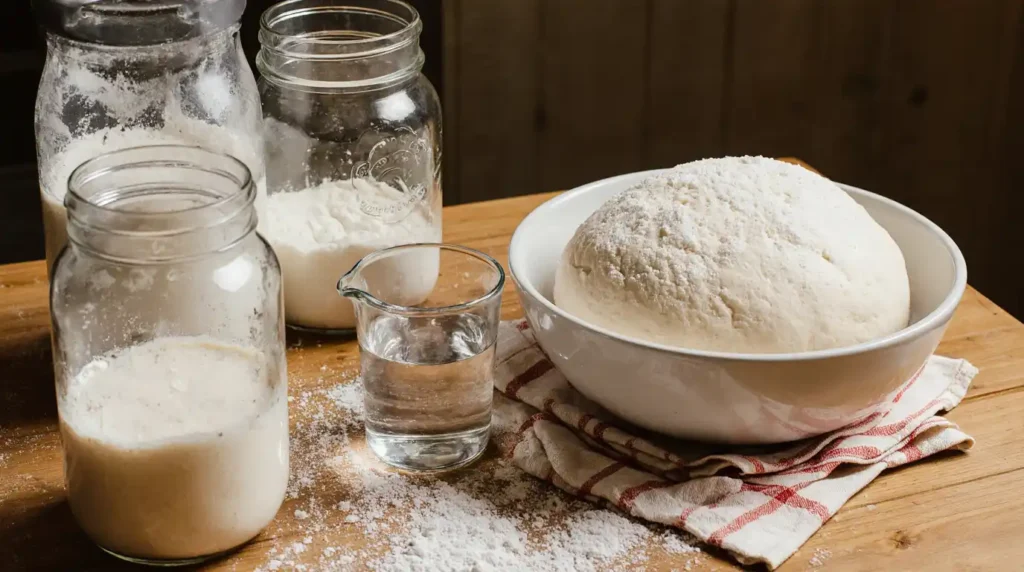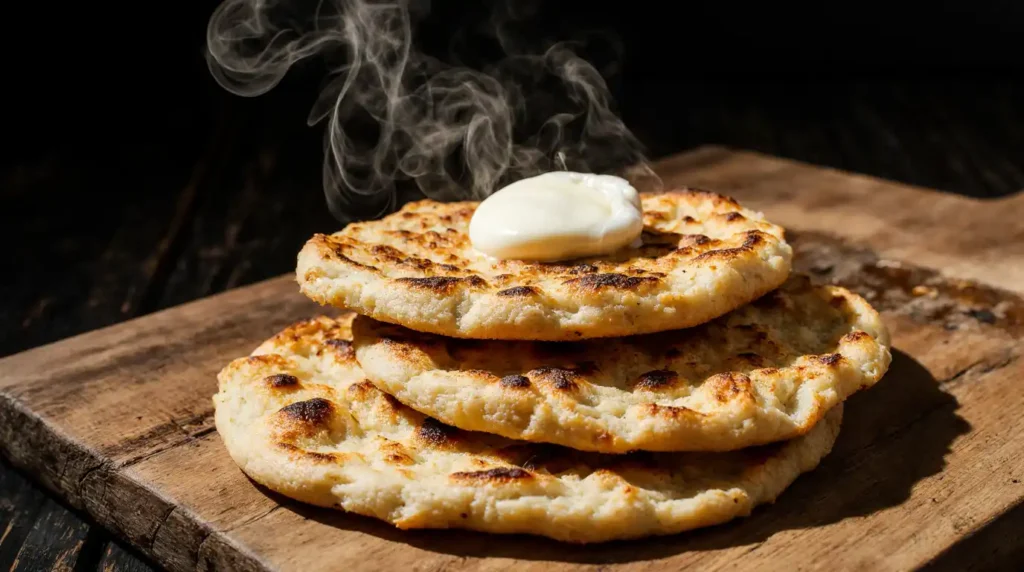If you’re here for sourdough pizza and flatbreads, you’re in for a treat — and maybe a bit of a (delicious) mess.
Let’s be real: there’s something magical about taking your starter — that wild, living culture you’ve kept alive with questionable dedication — and turning it into crackly, blistered pizza crust or soft, chewy flatbreads. It’s like leveling up from “I feed it so it doesn’t die” to “I use it to make something amazing.”
But I get it. Sourdough can feel intimidating enough on its own. Then you throw pizza or flatbreads into the mix, and suddenly you’re reading forums about hydration percentages, fermentation times, pizza stones, and everyone has an opinion. It’s easy to overthink it and just order takeout.
This guide is here to cut through the noise and make sourdough pizza and flatbreads actually doable at home. I’m talking:
- A pizza crust recipe that delivers those crisp, chewy, flavorful results (without a wood-fired oven).
- Simple, quick flatbreads that use up sourdough discard (because let’s not waste perfectly good culture).
- Topping ideas that complement sourdough’s tangy flavor.
- Real-life baking tips that help you avoid the classic pitfalls (hello, soggy middle).
Whether you’re a seasoned sourdough baker or someone who just hates tossing discard, you’ll find something here to try — and hopefully love.
Ready? Let’s roll up our sleeves, get some flour everywhere, and make the kind of homemade pizza and flatbreads that make your kitchen smell incredible.
Best Recipe for Sourdough Pizza and Flatbread Crust
Let’s get one thing straight right now: you can make amazing sourdough pizza at home without needing a thousand-dollar wood-fired oven or perfect technique.
Seriously.
It’s about working with your dough, not bullying it into submission. Sourdough pizza crust has a unique flavor — a little tang, a great chew — and it’s honestly forgiving if you treat it with some patience.
Below is my go-to method, adapted over years of sticky hands, burnt bottoms, and “oops, I forgot to stretch it properly” evenings.
Ingredients and Measurements for Sourdough Pizza and Flatbreads
- 500g bread flour (or 50/50 bread and 00 flour for a silkier texture)
- 325g water (65% hydration; adjust if you’re brave)
- 100g active sourdough starter (fed and bubbly)
- 10g salt
- 10g olive oil (optional but helps with extensibility)
Note: Don’t panic about exact percentages. This is homemade pizza, not lab work.
Step-by-Step Instructions for Sourdough Pizza and Flatbreads
- Mix
- Combine flour, water, and starter in a large bowl.
- Let it sit (autolyse) for 20–30 min. This relaxes the gluten before you even knead.
- Add Salt (and Oil)
- Sprinkle in the salt.
- Add olive oil if using.
- Mix until everything’s incorporated.
- Knead or Stretch & Fold
- Knead by hand 5–10 min, or do 3–4 stretch-and-folds over an hour.
- Don’t stress about perfect technique. You just want a smooth-ish, elastic dough.
- Bulk Ferment
- Cover and let it rise at room temperature until doubled — usually 4–6 hours, depending on starter strength and room temp.
- Want more flavor? Do a long cold fermentation in the fridge (12–48 hours).
- Divide and Pre-Shape
- Cut into 2–3 equal balls.
- Tuck edges under to create tension.
- Final Proof
- Let them rest at room temp for 1–2 hours (or overnight in the fridge for even better flavor).
- Shape Gently
- Press from center out.
- Don’t use a rolling pin — you’ll kill those beautiful bubbles.
- Aim for an even thickness with slightly raised edges.
- Top and Bake Hot
- Preheat your oven to its absolute maximum (475–550°F).
- Use a pizza stone or steel if you have one.
- Slide onto hot surface.
- Bake 8–12 minutes until the crust is blistered and golden.
BTW, your first one might be wonky-shaped. Who cares? It’s still pizza.
Pro Tips for Better Sourdough Pizza and Flatbreads Crust
- Cold fermentation is your friend. Flavors deepen, gluten relaxes.
- Hydration matters. Higher hydration = open, airy crust but trickier to handle.
- Flour your peel generously. Stuck pizza is no one’s friend.
- Preheat like crazy. Your stone or steel needs at least 45 min at max temp.

FAQ: Can I Freeze Sourdough Pizza Dough?
Short answer: Yes.
After dividing into balls, coat lightly with oil, wrap tightly, and freeze.
To use:
- Thaw overnight in fridge.
- Let come to room temp and proof 1–2 hours.
- Shape and bake as normal.
It won’t be exactly as airy as fresh, but it’s still really good.
TL;DR Sourdough Pizza and Flatbreads Recipe
- Mix flour, water, starter.
- Autolyse, add salt and oil.
- Knead/stretch-and-fold.
- Bulk ferment.
- Divide, pre-shape.
- Final proof.
- Shape, top, bake hot.
Pizza shouldn’t be scary. This is about making real, delicious sourdough pizza in your own oven — mess, flour clouds, imperfect circles, and all.
Sourdough Pizza and Flatbreads Using Discard
You know what drives me crazy? Watching people throw out perfectly good sourdough discard because they think it’s “waste.”
Honestly — don’t do it. That jar of sloppy, half-forgotten starter on your counter? It’s secret flatbread gold.
I can’t tell you how many times I’ve scraped out the last of my discard on a Sunday night, cursing myself for forgetting to feed it, only to make the best flatbreads I’ve ever tasted. They’re chewy. They’re warm. They have just enough sour kick to keep things interesting. And they come together in no time — like, less time than it takes to psych yourself up for a trip to the store.
Why Even Bother with Sourdough Pizza and Flatbreads?
Look, flour isn’t free. And tossing discard feels like throwing money in the trash. I’m not a saint, but I hate wasting food.
Plus, these flatbreads are weirdly versatile:
- Wrap them around grilled veggies or kebabs.
- Dunk them in soup.
- Slather them with butter and honey at midnight (no shame).
- Use them as a pizza base if you’re feeling fancy.
Honestly, half the time I don’t even plan to make them. I just realize “oh crap, I should use this discard” and half an hour later the house smells incredible.
My Go-To Discard Flatbread Recipe
Here’s how I make them — no fancy nonsense.
What you need:
- About a cup of sourdough discard. Old, hungry, ugly? Totally fine.
- A cup and a half (ish) of all-purpose flour.
- Half a teaspoon baking powder (makes them puff).
- A pinch of salt.
- A splash of olive oil or melted butter.
- Water — enough to bring it together (maybe a quarter cup, give or take).
What you do:
- Dump everything in a bowl. Don’t overthink it.
- Mix with your hands or a spoon until it’s a shaggy dough.
- Knead just enough so it holds together. Don’t worry about perfect smoothness.
- Let it rest 20–30 minutes. Cover it so it doesn’t dry out.
- Divide into balls — maybe 6 or 8 depending on how big you want them.
- Roll out on a floured counter. They’ll look rustic. That’s the charm.
- Heat a dry cast iron skillet or griddle. Medium-high.
- Cook each one ~1–2 minutes per side until you see golden spots and bubbles.
That’s it. You’re done.
Real Talk Tips
- If your discard is super runny? Use less water.
- Want them richer? Brush with butter after cooking.
- Feeling extra? Mix in garlic, herbs, za’atar, shredded cheese.
- Make a double batch and freeze half — they reheat beautifully.
And don’t worry if the first one is weirdly shaped. Happens to me every single time.

FAQ: Can I Use Whole Wheat Discard?
Yep! It’ll be a bit nuttier and denser, but still great. Sometimes I use half whole wheat flour just to make myself feel virtuous.
TL;DR: Sourdough Pizza and Flatbreads Summary
- Don’t throw away discard.
- Mix with flour, salt, baking powder, oil, water.
- Knead, rest, roll, cook on hot pan.
- Eat warm. Smile.
Listen — you don’t need to be some artisan baker with marble countertops to make these. You just need leftover starter, a hot pan, and a willingness to get flour on your shirt.
If you ask me? That’s the best kind of baking.
Topping Combinations That Work with Sourdough Flavor
Let’s talk toppings — because honestly, this is where sourdough pizza and flatbreads get really fun.
That little bit of tang from the sourdough changes everything. It’s not just bread anymore. It’s this rich, layered base that deserves toppings that can hang with it.
If you just dump cheap sauce and rubbery cheese on it? Eh. You’re missing half the point.
Classic Combos That Never Fail
First, don’t overcomplicate it if you don’t want to. Some classics are classics for a reason:
- Margherita: Crushed tomatoes, fresh mozzarella, basil, drizzle of olive oil. The sourdough’s tang + sweet tomato = perfect balance.
- Pepperoni: The salt and fat from good pepperoni cuts the sour beautifully. Throw on hot honey if you’re feeling bold.
- White Pizza: Ricotta, mozzarella, garlic, maybe spinach or arugula after baking. Super creamy against the tangy base.
These combos just work, even if you’re not a topping genius.
Creative or Gourmet Ideas
But let’s be honest — half the fun of homemade pizza is getting weird with it.
Here are some toppings I love with sourdough crust’s flavor:
- Fig & Prosciutto: Sweet figs (fresh or jam) + salty prosciutto + maybe a sprinkle of blue cheese. Sounds fancy, is actually easy.
- Roasted Veggies: Eggplant, zucchini, peppers — toss them with olive oil, salt, roast first so they don’t make the crust soggy.
- Caramelized Onion & Goat Cheese: Sweet, savory, tangy. Add some thyme or rosemary.
- Buffalo Chicken: Shredded chicken tossed in hot sauce + mozzarella + drizzle of ranch after baking. Trashy? Maybe. Delicious? Absolutely.
- Mushroom & Truffle Oil: Earthy flavors love the tangy base. Just don’t overdo the truffle oil unless you want it to smell like a fancy gas station.
I’m not saying you need to go full Food Network. But give sourdough crust some respect — it wants bold flavors.
Real Tips for Balancing Flavors
Here’s what I’ve learned after way too many experimental pizzas:
- Fat loves acid. Sourdough’s acidity pairs beautifully with creamy cheeses, cured meats, olive oil.
- Sweet balances sour. Honey, figs, even pineapple (yeah, I said it).
- Herbs matter. Basil, oregano, rosemary can lift everything.
- Don’t overload. Too many wet toppings = soggy crust. Restraint is your friend.
When in doubt? Fewer, better toppings.

FAQ: Can Sourdough Crust Handle Heavy Toppings?
Short answer: Yes — but treat it right.
Sourdough can hold a decent load if you don’t drown it in sauce. If you want lots of toppings:
- Par-bake the crust for 3–5 minutes before topping.
- Keep wet ingredients in check.
- Layer smartly — cheese on bottom can help prevent sogginess.
TL;DR: Sourdough Pizza and Flatbreads
- Classics work. Don’t overthink it.
- Sweet/salty combos shine.
- Roast veggies ahead.
- Go bold but don’t overload.
- Herbs make you look like you know what you’re doing.
Listen — the best part of making sourdough pizza and flatbreads at home is that there are no rules, just suggestions. Worst case? You eat your weird experiment anyway. Best case? You discover your new signature pie.
That’s the fun of it.
Baking Tips for Perfect Crust
Alright — so you’ve made your dough. It’s looking alive and bubbly, it smells amazing. But here’s where a lot of homemade sourdough pizzas go to die: the bake itself.
Honestly, this is the part that trips up most home bakers. Because getting that blistered, chewy, golden-brown crust in your average home oven isn’t automatic.
But it’s doable. I promise.
Here’s what actually works, no snobbery or fancy equipment required (though I’ll mention the nice-to-haves too).
Essential Tools (But Nothing Too Fancy)
You don’t need a professional pizza oven, but a few things help a lot:
- Pizza stone or steel: Game-changer. Preheat it forever. It stores heat so your crust gets that initial blast it needs.
- Cast iron pan: Surprisingly excellent for pan pizzas or even flatbreads. Holds heat beautifully.
- Peel or inverted baking sheet: Helps launch pizza onto the hot surface without turning it into a calzone by accident.
- Parchment paper: Training wheels. Nothing wrong with using it to avoid disasters.
If you don’t have any of this? Use a regular baking sheet flipped upside down. Works in a pinch.
How Hot Should My Oven Be?
Short answer: as hot as it’ll go.
Most home ovens cap out around 500–550°F. That’s fine.
- Preheat at least 45 minutes if using stone/steel. Don’t rush it.
- If you have convection? Use it — it evens the heat and browns the top better.
- For pan pizzas, you can bake a bit cooler (450–475°F), but expect a thicker crust.
Low temps are the #1 reason for sad, pale, bread-like pizza.
Shaping Without Tears (Literally)
- Let dough come to room temp before shaping. Cold dough fights you.
- Don’t use a rolling pin if you want bubbles. Press and stretch with your fingers.
- Work from center out. Push air to the edges.
- Embrace imperfect circles. It’s homemade.
Pro tip? If it keeps snapping back, let it rest 10–15 minutes. Gluten just needs to chill.
Avoiding the Dreaded Soggy Middle
Nobody wants pizza soup.
- Don’t overload on sauce. A thin layer goes a long way.
- Pre-roast wet veggies (mushrooms, peppers) so they don’t leak.
- Consider par-baking the crust for 3–5 minutes before topping if you’re worried.
- Use drier cheeses if possible. Fresh mozzarella is great, but pat it dry first.
Common Mistakes to Avoid
- Not preheating enough. Your stone/steel should be ripping hot.
- Overhandling the dough. You’ll knock out all those lovely fermentation bubbles.
- Piling on wet toppings. Sourdough crust is strong but not magic.
- Underbaking. Let it get golden and blistered. Undercooked dough is the worst.
FAQ: How Hot Should My Oven Be for Sourdough Pizza?
Answer: As hot as it’ll let you.
Most recipes say 475–550°F. The higher, the better. Preheat thoroughly and keep the door closed while it heats. If your oven has convection, use it.
TL;DR
- Preheat like your life depends on it.
- Use a stone, steel, or cast iron if you can.
- Shape gently. Don’t kill the bubbles.
- Watch your sauce and toppings.
- Bake hot and long enough for real color.
Here’s the thing: homemade pizza is always a bit messy. Even the “fails” are usually delicious. So don’t sweat perfection. Crank that oven, trust the process, and enjoy the smell of real sourdough baking in your own kitchen.
Conclusion
If you’ve made it all the way here, I hope you feel ready to try sourdough pizza and flatbreads in your own kitchen.
Honestly, it doesn’t have to be perfect. Mistakes are part of the fun. I’ve burned crusts, dropped dough on the floor, and shaped pizzas that looked like weird states on the map. But we still ate them — and they were delicious.
That’s the magic of sourdough: it’s alive, so it surprises you. It can’t be completely controlled, which is exactly why it tastes so good.
If there’s one thing to remember, it’s this:
- Trust your senses more than strict rules, because your nose and eyes know best.
- Don’t throw away that starter discard when you can turn it into something great.
- Try toppings that work with the tangy crust so each bite feels balanced.
- Heat your oven as much as you can to get those beautiful, blistered edges.
- Don’t worry about perfect shapes or results. Even the odd-looking pies are special.
Also, sourdough pizza and flatbreads are about sharing something you made yourself. Even if it’s not perfect, it’s yours.
So feed your starter, test a new topping idea, bake it hot, and invite someone to enjoy it with you. That’s what makes it all worth it.
If you want more ideas or help along the way, check out our other guides on starters, baking schedules, and shaping tips.
After all, in the end, it’s just flour, water, salt — and a little bit of magic you make at home.
Now go bake something amazing.
Link from starter care mention to: How to Care for Your Sourdough Starter
Link from Easy Sourdough Bread Recipe mention to: Easy Sourdough Bread Recipe
For flour or pizza technique: King Arthur Baking: Pizza Flour Guide
For safe food handling: FDA Food Safety Tips
If you tried these recipes or have your own favorite sourdough pizza and flatbreads ideas, leave a comment below! Let’s swap tips and keep baking.

